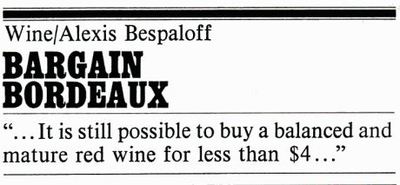
Browsing for some information about an old Bordeaux (the 1967 Château Beychevelle) a while ago led me to a 1973 New York Magazine story whose banner you see above. The author, Romanian-born Alexis Bespaloff, wrote about wine for the magazine from 1972 to 1996.
Bespaloff may be better known as the man who took over as editor of the Frank Schoonmaker Encyclopedia of Wine in 1976 following Schoonmaker’s death. The book, which went through several editions under Bespaloff’s guidance, has always been a favorite of mine, in part because it incorporates a feature lacking in every other compendium of vintage wisdom known to me: a pronouncing key.
Just knowing which syllables to accent when deftly slipping a word like Erzeugerabfulling (AIR-t’zoo-gher-ABB-foo-lung) into the convo can give a major boost to your wine expert cred, not to mention your self-esteem. Sadly, the book has not been updated since 1988 and although too out of date to be useful as a current guide to our much altered world of wine, its value as a kind of time capsule is considerable.
The burden of his aforementioned Nixon-era magazine column was the shocking rise in prices for better quality Bordeaux. The witty lead paragraph draws you into the piece like a magnet: A hundred years ago, when the red wines of Bordeaux were not as highly regarded as they are now, an English writer recommended sound claret as ‘an agreeable substitute for tea or coffee at breakfast during warm weather.’ The price of Bordeaux is increasing at such a fast rate today that we may soon have to drink tea and coffee as a disagreeable substitute [for sound claret] at every meal.
As a service to price-conscious readers, Bespaloff goes on to list 20 wines from solid, reputable estates whose 1966, 1967, and 1970 vintages were then available at New York City retailers for between $2.50 and $4 per bottle. Yes, you read that right.
The idea of classed-growth Bordeaux selling at these prices boggles our 21st century minds, too – but on a scale I’m sure neither Schoonmaker nor Bespaloff could have imagined. Then, you could have snagged a bottle of that 1967 Château Beychevelle Saint-Julien (classified as fourth-growth) for something like $5. Today you’ll fork over a Benjamin, easy.
What may strike the contemporary reader as even more marvelous than these antediluvian prices is the complete absence of detailed tasting notes and awarded points in Bespaloff’s stylish columns. General observations such as “well-made,” “balanced and mature,” “more forceful than charming” is about as far as he goes with the descriptive bits. It’s refreshing, I think.
But I’m not getting my hopes up that wine writing will back away from its florid excesses anytime soon. At least not until we see the return of $4 Bordeaux.